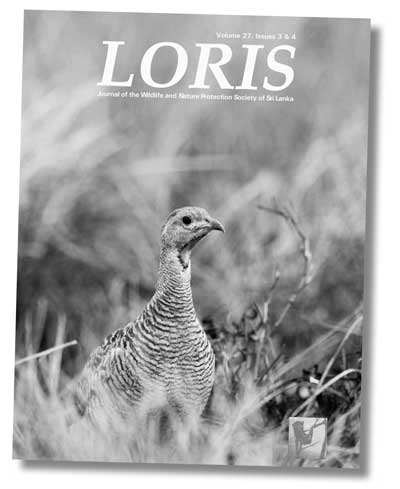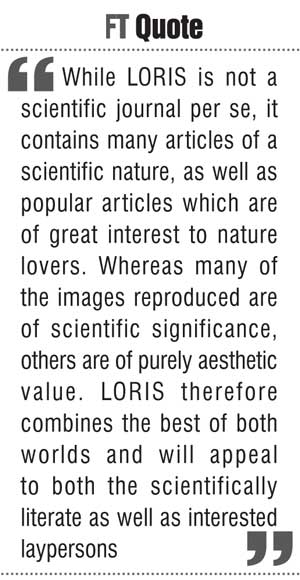Friday Apr 11, 2025
Friday Apr 11, 2025
Saturday, 8 October 2016 00:01 - - {{hitsCtrl.values.hits}}
 Reviewed by Rex I. De Silva
Reviewed by Rex I. De Silva
The WNPS originated as the ‘Ceylon Game Protection Society’ in 1894. In the mid-1930s the Society chose to publish a journal which first saw light in November 1936. The journal was called LORIS after the Slender Loris, a somewhat mysterious dweller of our jungles. The front cover contained an almost full-size painting of a loris by the artist Jan Cooke. Cooke’s illustration has appeared on the front cover of every issue of LORIS although in reduced format in more recent issues.
In its earliest years most of the Society’s members were hunters or anglers – many were both. Therefore the early issues contained many articles reflecting the interests of its members and dealt largely with game shooting, firearms and angling. Although such articles are not fashionable today, much valuable information on wildlife was contained in them.
To take just a few examples Prof. W.C.O. Hill wrote on the natural history of the loris, D.J.G. Hennessy on bears, R.S. Agar on the man-eating leopard of Punani, Dr. R.L. Spittle on the vanishing veddas (sic) and W.W.A. Phillips on the Frogmouth. Many more interesting articles were written in those early days and anyone with the time to spare will find a surfeit of instructive and entertaining  articles in copies of Loris in the Library of the WNPS at Battaramulla.
articles in copies of Loris in the Library of the WNPS at Battaramulla.
Conservation was given lip-service and for the most part only as far as protection of game animals was concerned and little attention was paid to the broader aspects of nature conservation and protection. This was to change with time. The first Joint Editors were Professor W.C.O. Hill and Dr. R.L. Spittle. Over the years they were followed by many other renowned and distinguished individuals, culminating in recent years with Rohan Pethiyagoda, Devaka Weerakoon and the present editor Rohan Wijesinha.
In the post-independence era and especially from the late 1950s through the 1960s many of the hunting fraternity, most of whom were expatriates, left Sri Lanka. This resulted in a transfer of interest from articles aimed primarily at hunters and anglers to accounts on natural history in all its aspects. As such, the years following saw many more articles on conservation and environmental issues.
After a series of name changes, the Society became The Wildlife and Nature Protection Society of Ceylon (later Sri Lanka) in 1971. This reflected a change from protection of game animals for hunting to protection of the entire fauna, flora and environment of Sri Lanka. No more were members regaled with the prowess of a few hunters, instead articles concentrated on studies on the various aspects of Sri Lankan animal and plant groups. A random sample would include articles on miocene vertebrate fossils, the impact of climate change on biodiversity, DNA study on fruit bats, Okanda National Park, dragonfly fauna of Sri Lanka, the human-elephant conflict, visual identification of leopards, tuskers of yala, the red-faced malkoha and numerous items on fishing cats, leopards, elephants and birds.
Biographies of renowned naturalists and conservationists like P.B. Karunaratne, V. Athukorala, Thilo W. Hoffmann and others were published in its pages. An important feature of LORIS is the book reviews. Many of the standard works on Sri Lanka’s animal and plant life were first reviewed in its pages.
Probably the feature most appreciated by readers is the images. Images by veterans like Lal Anthonis, Dr. T.S.U. de Zilva, Rukshan Jayewardene, Namal Kamalgoda and others have appeared along with those captured by many amateurs who, benefiting from modern digital photography, produce images of near professional quality.
An interesting development in recent years has been an increased interest in our marine environment. This has resulted in several articles and papers on the marine sciences of Sri Lanka. Significant accounts by Sri Lanka’s cetacean expert Asha de Vos have introduced many to the wonders of our marine life as well as to the threats to our marine environment. Naren Gunasekera’s underwater images in the latest issue will surely be appreciated and enjoyed by readers. Ranil Nanayakkara has written an interesting note on our endangered Dugongs. No doubt more articles dealing with our marine life will follow.
While LORIS is not a scientific journal per se, it contains many articles of a scientific nature, as well as popular articles which are of great interest to nature lovers. Whereas many of the images reproduced are of scientific significance, others are of purely aesthetic value. LORIS therefore combines the best of both worlds and will appeal to both the scientifically literate as well as interested laypersons.
The format of LORIS has recently been enlarged somewhat and current issues are approximately 30x21 cm. The journal is printed on quality paper and the plates are high-quality colour reproductions. The current issue vol. 27 (3&4) has 70 pages.
So where does LORIS stand today? It is the only popular journal dealing with Sri Lanka’s wildlife and environment. Sadly, other comparable journals have made their appearance, gone through a few issues and then disappeared. Not so LORIS which has appeared continuously for 80, yes 80, years. Even during WWII Loris appeared without interruption.
So whether you are a scientist, naturalist or nature lover there will always be something of interest in its pages. LORIS can be purchased from the WNPS office at Battaramulla. Better still join the Society; members receive free copies of each issue!
Discover Kapruka, the leading online shopping platform in Sri Lanka, where you can conveniently send Gifts and Flowers to your loved ones for any event including Valentine ’s Day. Explore a wide range of popular Shopping Categories on Kapruka, including Toys, Groceries, Electronics, Birthday Cakes, Fruits, Chocolates, Flower Bouquets, Clothing, Watches, Lingerie, Gift Sets and Jewellery. Also if you’re interested in selling with Kapruka, Partner Central by Kapruka is the best solution to start with. Moreover, through Kapruka Global Shop, you can also enjoy the convenience of purchasing products from renowned platforms like Amazon and eBay and have them delivered to Sri Lanka.
Discover Kapruka, the leading online shopping platform in Sri Lanka, where you can conveniently send Gifts and Flowers to your loved ones for any event including Valentine ’s Day. Explore a wide range of popular Shopping Categories on Kapruka, including Toys, Groceries, Electronics, Birthday Cakes, Fruits, Chocolates, Flower Bouquets, Clothing, Watches, Lingerie, Gift Sets and Jewellery. Also if you’re interested in selling with Kapruka, Partner Central by Kapruka is the best solution to start with. Moreover, through Kapruka Global Shop, you can also enjoy the convenience of purchasing products from renowned platforms like Amazon and eBay and have them delivered to Sri Lanka.